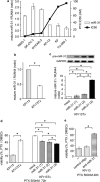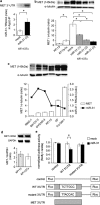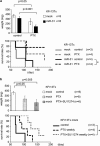Downregulation of miRNA-31 induces taxane resistance in ovarian cancer cells through increase of receptor tyrosine kinase MET
- PMID: 23552883
- PMCID: PMC3641356
- DOI: 10.1038/oncsis.2013.3
Downregulation of miRNA-31 induces taxane resistance in ovarian cancer cells through increase of receptor tyrosine kinase MET
Abstract
Ovarian cancer is one of the most aggressive female reproductive tract tumors. Paclitaxel (PTX) is widely used for the treatment of ovarian cancer. However, ovarian cancers often acquire chemotherapeutic resistance to this agent. We investigated the mechanism of chemoresistance by analysis of microRNAs using the ovarian cancer cell line KFr13 and its PTX-resistant derivative (KFr13Tx). We found that miR-31 was downregulated in KFr13Tx cells, and that re-introduction of miR31 re-sensitized them to PTX both in vitro and in vivo. miR-31 was found to bind to the 3'-UTR of mRNA of MET, and the decrease in MET correlated to higher sensitivity to PTX. Furthermore, co-treatment of KFr13Tx cells with MET inhibitors sensitized the tumor cells to PTX both in vitro and in vivo. In addition, lower levels of miR31 and higher expression of MET in human ovarian cancer specimens were significantly correlated with PTX chemoresistance and poor prognosis. This study demonstrated miR31-dependent regulation of MET for chemoresistance of ovarian cancer, raising the possibility that combination therapy with a MET inhibitor and PTX will increase PTX efficacy.
Figures





Similar articles
-
miR-363 confers taxane resistance in ovarian cancer by targeting the Hippo pathway member, LATS2.Oncotarget. 2018 Jul 10;9(53):30053-30065. doi: 10.18632/oncotarget.25698. eCollection 2018 Jul 10. Oncotarget. 2018. PMID: 30046387 Free PMC article.
-
SNHG5 enhances Paclitaxel sensitivity of ovarian cancer cells through sponging miR-23a.Biomed Pharmacother. 2020 Mar;123:109711. doi: 10.1016/j.biopha.2019.109711. Epub 2019 Dec 26. Biomed Pharmacother. 2020. PMID: 31884343
-
Dysregulation of miR-106a and miR-591 confers paclitaxel resistance to ovarian cancer.Br J Cancer. 2013 Jul 23;109(2):452-61. doi: 10.1038/bjc.2013.305. Epub 2013 Jun 27. Br J Cancer. 2013. PMID: 23807165 Free PMC article.
-
circCELSR1 (hsa_circ_0063809) Contributes to Paclitaxel Resistance of Ovarian Cancer Cells by Regulating FOXR2 Expression via miR-1252.Mol Ther Nucleic Acids. 2020 Mar 6;19:718-730. doi: 10.1016/j.omtn.2019.12.005. Epub 2019 Dec 18. Mol Ther Nucleic Acids. 2020. PMID: 31945729 Free PMC article.
-
Medical therapy of advanced malignant epithelial tumours of the ovary.Forum (Genova). 2000 Oct-Dec;10(4):323-32. Forum (Genova). 2000. PMID: 11535983 Review.
Cited by
-
microRNA 31 functions as an endometrial cancer oncogene by suppressing Hippo tumor suppressor pathway.Mol Cancer. 2014 Apr 29;13:97. doi: 10.1186/1476-4598-13-97. Mol Cancer. 2014. PMID: 24779718 Free PMC article.
-
MicroRNA profiling implies new markers of chemoresistance of triple-negative breast cancer.PLoS One. 2014 May 2;9(5):e96228. doi: 10.1371/journal.pone.0096228. eCollection 2014. PLoS One. 2014. PMID: 24788655 Free PMC article.
-
Application of microRNA in diagnosis and treatment of ovarian cancer.Biomed Res Int. 2014;2014:232817. doi: 10.1155/2014/232817. Epub 2014 Apr 15. Biomed Res Int. 2014. PMID: 24822185 Free PMC article. Review.
-
The role and mechanisms of action of microRNAs in cancer drug resistance.Clin Epigenetics. 2019 Feb 11;11(1):25. doi: 10.1186/s13148-018-0587-8. Clin Epigenetics. 2019. PMID: 30744689 Free PMC article. Review.
-
The Significance of MicroRNAs Expression in Regulation of Extracellular Matrix and Other Drug Resistant Genes in Drug Resistant Ovarian Cancer Cell Lines.Int J Mol Sci. 2020 Apr 9;21(7):2619. doi: 10.3390/ijms21072619. Int J Mol Sci. 2020. PMID: 32283808 Free PMC article.
References
-
- Boyle P, Levin B.World cancer report 2008 World Health Organization, Lyon; 2008. 2008.
-
- Landis SH, Murray T, Bolden S, Wingo PA. Cancer statistics, 1999. CA Cancer J Clin. 1999;49:8–31. - PubMed
-
- Cannistra SA. Cancer of the ovary. N Engl J Med. 2004;351:2519–2529. - PubMed
-
- Kristensen GB, Trope C. Epithelial ovarian carcinoma. Lancet. 1997;349:113–117. - PubMed
LinkOut - more resources
Full Text Sources
Other Literature Sources
Miscellaneous

